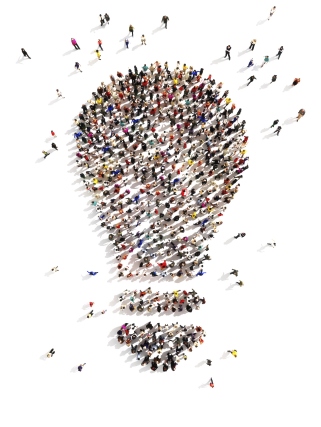Navigating the nuances of organizational knowledge management is often challenging. I find myself toying with the idea that we take knowledge for granted. Maybe the complexities of knowledge are just too much – individual, collective, explicit, tacit, organized, mediated, structured – the list goes on. In a recent exchange about potential changes to the scholarly peer review process, this complexity became apparent. Without people, there is no knowledge management. I know this is a bold statement, but I charge you to think about what the world would be like in the absence of those who organize our contributions to science. A world without librarians? No, thank you. Creating, sharing, and transferring knowledge is inherently human, existing in our realities and relationships.

Nahapiet and Ghoshal (1998) present a theoretical frame for the ways in which human, intellectual, and social capital intertwine in the processes of creating and sharing knowledge. It is important to discern each of these types of capital to recognize the unique contribution of each to knowledge. Human capital refers to acquired knowledge, skills, and capabilities that enable novel interaction. Intellectual capital refers to a larger social collectivity of knowledge and expertise of knowing, in particular, the types of knowledge and the levels of analysis and knowing. Types of knowledge include “know-how” and “procedural” knowledge, which are critical to knowledge continuity (Dalkir, 2010). Spender (1996) presents a matrix for understanding the levels of analysis and knowing, which “concerns the degree to which it is possible to consider a concept of organizational, collective, or social knowledge that is different from that of individual, organizational members” (Nahapiet & Ghoshal, 1998, p. 246). These categories, which discern the explicit and the tacit, include conscious, automatic, objectified, and collective knowledge. Conscious knowledge refers to facts, concepts, and frameworks stored and retrieved from memory or records. Automatic knowledge is theoretical and practical, often in the form of different kinds of artistic, athletic, or technical skills. Objectified knowledge is a collection of explicit knowledge. Collective knowledge is “embedded in the forms of social and institutional practice, and that resides in the tacit experiences and enactment of the collective” (Nahapiet & Ghoshal, 1998, p. 247). All of these integral elements combine to form intellectual capital.
Social capital is a more complex, multidimensional construct that includes structural, relational, and cognitive dimensions (Nahapiet & Ghoshal, 1998). The structural dimension refers to the overall pattern of connections including network ties, network configuration, and appropriable organization. Th relational dimension reflects how relationships influence behavior. These relationships are affected by trust, norms, obligations, and identification. Lastly, the cognitive dimension refers to resources that facilitate shared languages, codes, and narratives. From an organizational perspective, intellectual and social capital are critical to organizational advantage. In reflecting on these types of capital, it is important to recognize that knowledge must transfer from the individual to the collective, from tacit to explicit, and vice versa in order to foster Hara’s (2009) common language.
 Knowledge transfer is inherent in many of the above categories and dimensions of social and intellectual capital. Knowledge transfer “is the process through which one unit (e.g., group, department, or division) is affected by the experience of another.” ( Argote & Ingram, 2000, p. 151). As we know, knowledge is anchored in many organizational functions including its tools, technology, tasks, relationships, and networks. The embedded nature of knowledge affects the way it is transferred to organizations including (1) characteristics of the source of knowledge, the recipient, the context, and the knowledge itself, (2) causal ambiguity, (3) the characteristics of individual members (i.e., ability and motivation), and (4) the strong and weak ties in social networks.
Knowledge transfer is inherent in many of the above categories and dimensions of social and intellectual capital. Knowledge transfer “is the process through which one unit (e.g., group, department, or division) is affected by the experience of another.” ( Argote & Ingram, 2000, p. 151). As we know, knowledge is anchored in many organizational functions including its tools, technology, tasks, relationships, and networks. The embedded nature of knowledge affects the way it is transferred to organizations including (1) characteristics of the source of knowledge, the recipient, the context, and the knowledge itself, (2) causal ambiguity, (3) the characteristics of individual members (i.e., ability and motivation), and (4) the strong and weak ties in social networks.
Lucas (2005) utilizes social information processing theory to argue that “prior experiences help us to determine what accurately reflects the facts and what does not” (p. 89). More importantly, Lucas (2005) demonstrates the significance of social capital in knowledge transfer, namely the relational dimension, in a study investigating a Fortune 500 company. He discovered the importance of trust and the reputation of knowledge providers and recipients. Lucas (2005) also explains that dilemmas in knowledge transfer may occur as a direct result of technology, which supports the significance of relational, structural, and cognitive social capital. He maintains that “access to information does not guarantee its use. There must be some other basis upon which trust is developed” (p. 97).
No matter how technology progresses, people create trust in and build a reputation for organizational knowledge management systems.
References
Argote, L, & Ingram, P. (2000). Knowledge transfer: A basis for competitive advantage in firms. Organizational Behavior and Human Decision Processes, 82(1), 150-169. doi:10.1006/obhd.2000.2893
Dalkir, K. (2010). Knowledge management. Encyclopedia of Library and Information Science (3rd Ed.). doi:10.1081/E-ELIS3-120043816
Hara, N. (2009). Communities of practice: Fostering peer-to-peer learning and informal knowledge sharing in the work place. Information Science and Knowledge Management (Vol. 13). Berlin: Springer-Verlag.
Lucas, L. M. (2005). The impact of trust and reputation on the transfer of best practices. Journal of Knowledge Management, 9(4), 87-101. doi:10.1108/13673270510610350
Nahapiet, J., & Ghoshal, S. (1998). Social capital, intellectual capital, and the organizational advantage. The Academy of Management Review, 23(2), 242-266.
Spender, J. C. (1996). Making knowledge the basis of a dynamic theory of the firm. Strategic Management Journal, 17, 45–62. doi:10.1002/smj.4250171106
Your entire article brought to life the issue I’ve been thinking about recently. The stereotypes and ideas surrounding information management professions. You say “A world without librarians? No, thank you. Creating, sharing, and transferring knowledge is inherently human, existing in our realities and relationships.” and “No matter how technology progresses, people create trust in and build a reputation for organizational knowledge management systems.” These comments made me think about how a lot of people I speak to outside my profession just don’t understand why my career is important. I was a part of a talk the other day that discussed the fact that our profession (archives specifically) is chronically underpaid because it used to be clerical work and those assumptions haven’t really changed. I wonder if all of these theories about knowledge management can be applied to the knowledge of our profession by those outside it?
That’s a good question. I think those that recognize the importance of knowledge, no matter the context, also recognize the importance of the people and systems who manage it.
“without people there would be no knowledge management”. Yes this is a bold statement, but it is one I think I agree with. Shoot, without people, there would be no knowledge to manage. It makes me think of customer knowledge management where the customers are what drive the knowledge management. Case in point: starbucks.
Absolutely! Glad you agree.
I enjoyed your statement about the world with no librarians. I don’t think many people realize that a large portion of our jobs is to act as information filters to prevent information overload.
When I realized where you were headed with this post and your last one, I held off on reading or putting together comments because I’d found my own thoughts heading in a similar direction (albeit more poorly expressed, perhaps). I expect I’ll start uploading the first of my comments in the next few days, so I’ve gone ahead now. Akeller24 hinted at it on the 4th of March, and Mary discussed it explicitly back in mid-February.
Perhaps this would be better-served by a more general forum, but here will do, I think, because you summarized it the best: “Creating, sharing, and transferring knowledge is inherently human, existing in our realities and relationships.” Most of the articles we’ve collectively read which deal with the human elements of knowledge transfer avoid stating something like this directly, but many of us seem to have come to the same conclusion. I’m rambling, but I think it’s worth noting, and my hat’s off to you for pointing it out so succinctly.